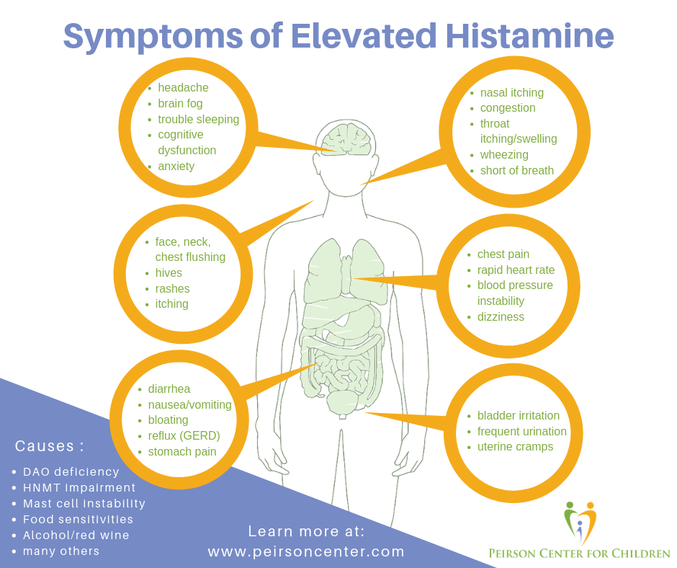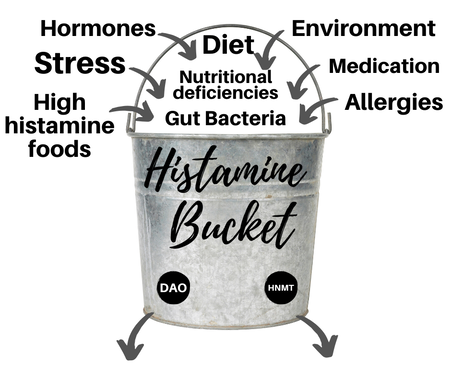HISTAMINE INTOLERANCE SUPPORT
Histamine intolerance is a problem that can have significant consequences to the health and development of children. It not only causes rashes, runny noses and itchy, watery eyes. It also acts as an excitatory neurotransmitter and plays a significant role in the sleep-wake cycle. (Thakkar, 2011) High levels of histamine in the body can impair sleep. It can also have a significant impact on their behavior and has been linked to anger and aggression. (Yanai, 2017) More importantly histamine plays a big role in the immune system. It is a major peripheral inflammatory mediator. As well, it is involved in the initiation and sustaining of autoimmune disease. (Chen, 2015)
Histamine is metabolized or cleared from the body via two enzymes, histamine methyltransferase (HNMT) and diamine oxidase (DAO). HNMT is dependent on adequate amounts of SAMe to provide a methyl group in order for it to be effective. Children who have methylation issues like those with a folate or B12 deficiency secondary to malabsorption, autism, Down syndrome, autoimmune disease like PANS/PANDAS and others are at increased risk for histamine intolerance. DAO is an enzyme found in the gut that metabolizes histamine in the GI tract, which can be a significant source of histamine, especially in the presence of SIBO, candida overgrowth and certain pathogenic infections like Klebsiella spp. and Morganella morganii, to name just two.
For more information you can read Histamine and histamine intolerance.
Histamine is metabolized or cleared from the body via two enzymes, histamine methyltransferase (HNMT) and diamine oxidase (DAO). HNMT is dependent on adequate amounts of SAMe to provide a methyl group in order for it to be effective. Children who have methylation issues like those with a folate or B12 deficiency secondary to malabsorption, autism, Down syndrome, autoimmune disease like PANS/PANDAS and others are at increased risk for histamine intolerance. DAO is an enzyme found in the gut that metabolizes histamine in the GI tract, which can be a significant source of histamine, especially in the presence of SIBO, candida overgrowth and certain pathogenic infections like Klebsiella spp. and Morganella morganii, to name just two.
For more information you can read Histamine and histamine intolerance.
The supplements linked below may help lower histamine levels via different mechanisms.
Create a Fullscript account to receive a 15% discount.
Create a Fullscript account to receive a 15% discount.
|
Diamine oxidase (DAO) has been clinically tested and found to break down food-derived histamine in the digestive tract.*
Quercetin Ascorbate powder is a powerful flavonoid and antioxidant blend. Quercetin is one of several flavonoids that have effects on mast cells and basophils. Vitamin C helps regulate histamine levels and supports a healthy inflammatory response.*
Elevated levels of histamine in the body use up a lot of SAMe (s-adenosylmethonine). SAMe is our body's major methyl donor. Low levels of methyl donors can lead to low glutathione levels, which is our body's major antioxidant compound.
|
ProBiota HistaminX contains only probiotic species that are considered "histamine-friendly" and excludes those known to produce histamine in the gut.*
HistaEze contains quercetin, nettle leaf and vitamin C, all of which have long histories of use in helping to support immune balance during the allergy season. Additionally, bicarbonate salts are included for their role in maintaining normal histamine metabolism.*
Zeolite has been shown to bind histamine in the gut. (Dathe, 2018)
|
HistaminX by Seeking Health provides a combination of supportive herbal and plant-derived compounds that may work together to support seasonal comfort and a healthy inflammatory response.*
Allersodes are homeopathic attenuations of antigens, which are substances that in moderate or large doses cause the production of antibodies. Diluted homeopathic doses of these antigens are intended to dampen the body’s hyper-responsiveness, thus desensitizing.*
|
*These statements have not been evaluated by the Food and Drug Administration. This product is not intended to diagnose, treat, cure, or prevent any disease.


